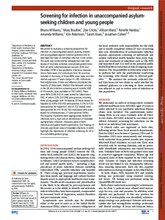Abstract
We aimed to evaluate a screening programme for infection in unaccompanied asylum seeking children and young people against national guidance and to describe the rates of identified infection in the cohort. The audit was conducted by retrospective case note review of routinely collected, anonymised patient data from all UASC referred between January 2016 and December 2018 in two paediatric infectious diseases clinics.There were 252 individuals from 19 countries included in the study, of these 88% were male, and the median age was 17 years (range 11–18). Individuals from Afghanistan, Eritrea and Albania constituted the majority of those seen. Median time between arriving in the UK and infection screening was 6 months (IQR 4–10 months, data available on 197 UASC). There were 94% (238/252) of cases tested for tuberculosis (TB), of whom 23% (55/238) were positive, including three young people with TB disease. Of those tested for hepatitis B, 4.8% (10/210) were positive, 0.5% (1/121) were positive for hepatitis C and of 252 tested, none were positive for HIV. Of the 163 individuals who were tested for schistosomiasis, 27 were positive (16%).The majority of patients were appropriately tested for infections with a high rate of identification of treatable asymptomatic infection. Infections were of both individual and public health significance. Our findings of clinically significant rates of treatable infections in UASC highlight the importance of infection screening for all in this vulnerable patient group.

